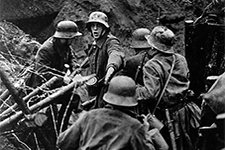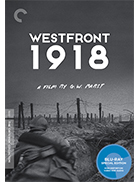Westfront 1918
|  G.W. Pabst's Westfront 1918, which appeared in German theaters at roughly the same time that Lewis Milestone's similarly themed All Quiet on the Western Front (1930) was playing in U.S. theaters, was the great director's first synchronized sound effort and marked a significant shift from the kinds of films he had been making since his cinematic debut in 1923 with The Treasure. His most well-known films up until that point had focused primarily on memorable female protagonists played by actresses who became icons as a result (Greta Garbo in 1925's The Joyless Street, Louis Brooks in 1929's Pandora's Box and Diary of a Lost Girl, and Leni Riefenstahl in 1929'sWhite Hell of Pitz Palu). A dedicated realist, Pabst was a constituent part of the "new realism" movement in German cinema that was gradually superseding expressionism. As he once put it, "What need is there for romantic treatment? Real life is too romantic, too ghastly." Westfront 1918 was an entirely different kind of film from his previous social dramas, and yet it was one for which Pabst, with his focus on realism both physical and psychological, turned out to be extremely well suited. Based on the 1930 novel Four Infantrymen on the Western Front (Vier von der Infanterie) by Ernst Johannsen, the focus of the story is divided among four relatively ordinary German soldiers: The Bavarian (Fritz Kampers), Karl (Gustav Diessl), The Student (Hans-Joachim Möbis), and The Lieutenant (Claus Clausen). Much of the first half of the film, which is set in France during the worst days of the trench warfare in 1918, depicts the four protagonists on a short furlough. The incidents are fairly banal and predictable, showing primarily the way in which the soldiers' duty to war interferes with their lives. The student, for example, spends time with and falls in love with a French waitress named Yvette (Jackie Monnier), who he must soon leave behind in order to return to the trenches. Karl, on the other hand, discovers that his wife (Hanna Hoessrich) has been unfaithful to him during his absence, which only compounds the pain of warfare by bringing it into his bedroom-a place where he thought he would find brief solace, but instead discovers betrayal in the worst way. The film also conveys in no uncertain terms how harsh life is on the homefront, as Karl's mother (Else Heller) is reluctant to leave a breadline when she catches sight of her son in the streets, which combined with Karl's wife's infidelity reinforces how the war was starving the people left behind both physically and emotionally. However, Pabst's real achievement in Westfront 1918 is his depiction of war, which dominates the film's second half with an onslaught of hard-edged violence that is depicted with a kind of dispassionate, redundant realism that undermines any sense of melodramatic heroism or adventurous excitement. Pabst's depiction of trench warfare is monotonous, dirty, claustrophobic, and repetitive, with the men doing little more than trying to survive the bullets and shells, some of which come from their own comrades (not surprisingly, its clearly anti-war sentiment caused it to be immediately banned by Hitler's regime once they came to power in 1933). Although synchronized sound was a relatively new innovation at the time, Pabst and sound editor W.L. Bagier utilize it with great dexterity to give sonic weight to the literal blood and thunder. The soundtrack is understandably limited by today's standards, but it is also undeniable in heightening the impact of the violence and the characters' sense of entrapment. The trenches themselves become a metaphor for war, with the men scurrying through the earthen works that sometimes protect them, but other times collapse on them. It is a powerful visual reminder of the atrocities of war, and Westfront 1918, despite having fallen to the wayside of many film histories, remains a powerful testament to its physical, psychological, and spiritual horrors.
Copyright © 2018 James Kendrick Thoughts? E-mail James Kendrick All images copyright © The Criterion Collection | |||||||||||||||||||||||||||||||
Overall Rating: 


 (3.5)
(3.5)


